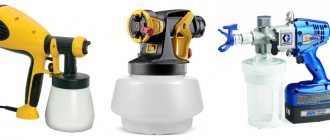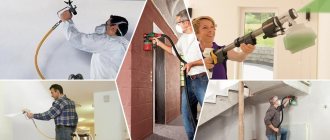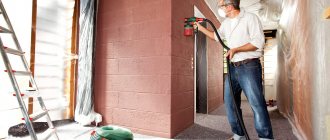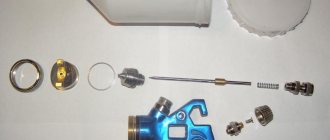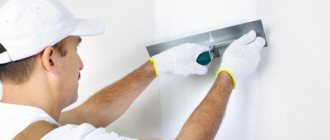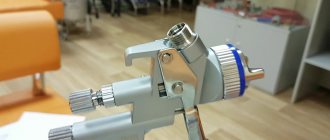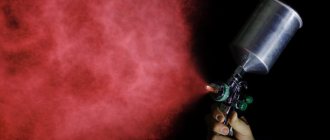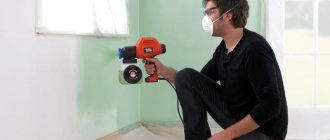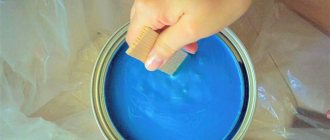Published: 12/06/2016
Rating:
Tags:Choosing a spray gunAirless spray gunAir spray gun
During the process of car repair, from time to time there is a need to paint local areas or the entire surface. For this purpose, use a brush, roller or spray gun - airless or air.
The debate about which spray gun is more effective - air or airless - does not subside; each option has its supporters and opponents. The answer to this question is extremely simple - which spray gun is better depends on the nature of the work being performed.
Below we will look at what airless paint sprayers are, we will analyze the principle of operation of such a device and talk about which spray gun is best suited for a particular task. This information will help you make the right choice if the question arises about what equipment to purchase for your garage.
Painting a car using a spray gun
See also:
The best models of Stab spray guns
How does an airless spray gun work?
The painting equipment market has been updated with airless devices. Company managers recommend purchasing an airless spray gun for different types of paints and varnishes.
Brief overview of the tool
Models for airless spraying of paints and varnishes work efficiently and are easy to use. The device uses the principle of crushing, which allows the paint to lie on the surface more evenly and dry faster.
Design and principle of operation of an airless sprayer
Spray guns, powered by electricity or pneumatics, had an upper or lower tank; sometimes the paint was force-fed from a pump. An airless sprayer operates using different operating principles: paint enters the hose under high pressure and is sprayed through a nozzle with a small diameter in the form of a torch with clear boundaries. The device copes well with painting plastic and aluminum products. At all stages of work, a special safety system is used to ensure operator safety.
The thin cleaning filter eliminates the risk of mechanism breakdown when working in dusty or dirty rooms. An important part of the spray gun design is the electric motor that supplies paint to the nozzle.
The following types of paints and varnishes can be poured into the tank of the device:
The device is powered from a household or industrial electrical network. The operation of the spray gun is improved by a rotating mechanism that helps the paint get into hard-to-reach places. Unplanned start is prevented by a safety guard. The metal-ceramic nozzle is the main part of the device. It is made in the shape of a cylinder.
The drive system of the mechanism comes in different types:
The electrical system is more suitable for domestic conditions; in production, such a drive is less common. The device is compact and easy to transport. It is not recommended to use the unit in fire hazardous areas.
The gasoline drive consists of a motor running on liquid fuel. It is more efficient than electric and does not depend on the presence of a network. The disadvantage is the formation of exhaust gases; exhaust gases must be removed from the room.
A pneumatic installation is an industrial equipment that is used to process large areas. The work is done quickly, especially with good ventilation. You can perform actions without ventilation.
Any type of drive provides high pressure at which paint enters the nozzle, and from it onto the surface of the object being painted.
Pros and cons of the tool
The soft torch distributes the material in an even thin layer over the surface, which improves the quality of work. Under the influence of pressure, dye particles are transferred without turbulence in the air, which increases productivity. The benefits also include saving time and materials. Before processing objects, it is not necessary to carry out special preparation of surfaces.
The disadvantage of using a spray gun is the inability to paint products of complex shapes. The product is processed unevenly, and sagging forms on the bulges. Particles of paint released under high pressure bounce off the part and form a shagreen surface. If you select the wrong nozzle and select the wrong pressure, you may not have time to react to the incorrect speed of spraying the paint and varnish composition.
The equipment after work needs to be completely cleaned, otherwise the quality of further painting will sharply decrease.
Scope of application of airless spray guns
Airless spray gun is used:
- in car services;
- in furniture factories;
- in workshops for the production of windows and doors;
- at car factories;
- in car parks;
- on the railway;
- in shipbuilding.
How to use this tool
To obtain a high-quality result, you need to use the tool correctly. The old layer of paint or varnish must be removed from the surface of the walls and ceiling if you plan to renovate the house. A portion of paint is poured into the tank of the device, the device is configured, and the parameters and performance of the device are checked.
When the “Start” button is pressed, the formation of a torch is assessed, which is directed to a sheet of cardboard or paper in a vertical position. If streaks appear, it is necessary to change the consistency of the paint and reduce the power of the sprayer. The viscosity of varnish or other materials is changed by adding a solvent. When a high-quality torch appears, they begin painting the parts. It is better to keep the device level, do not tilt it in different directions and do not swing it. When painting wooden surfaces, the torch is directed along the fibers.
Avoid contact of the mixture with the skin, as this can cause injury due to the high pressure. After turning off the device, the remaining pressure is released by pressing the lever or opening a special valve.
At the end of the work, the device is turned off and disconnected from the turbine. The remaining paint is drained from the tank and the container is washed. Particular attention is paid to cleaning the nozzle channels. Do not use metal brushes to care for the device, as... they leave deep scratches on metal and plastic. Before storing the parts, they are lubricated with products that do not contain silicone.
What is an air spray gun and how is it different?
This type of spray gun has a built-in or remote compressor in its design, which is responsible for supplying the mixture to the gun nozzle. The product comes with an upper, lower tank and a pressure pump.
The main difference from other sprayers is the method of supplying the liquid composition. The process is carried out by gravity using air pressure (up to 8 Bar).
The main advantage of the model is that when sprayed, a soft stream emerges, which forms a thin layer of paintwork on the surface, which is optimal for painting embossed products.
The downside of the installation is high paint consumption. Due to the low pressure, many particles of the mixture do not reach the object, resulting in fog forming around the painter, which reduces visibility.
Equipment selection criteria
When choosing a model, you need to pay attention to the diameter of the nozzle. It should be of such a size that a torch with a diameter of up to 80 cm is formed. A larger diameter is found in professional models, but they consume a lot of paint - 200-500 ml/min. Non-professionals are advised to choose a device with lower consumption; the power of such devices is 400-1000 W.
Important parameters of spray guns include the ability to spray paint material of acceptable viscosity. For water-based mixtures this figure is 50-80 Din.
Equally important for ease of use are the following criteria:
- comfortable handle;
- low noise level;
- the presence of a flexible nozzle attachment;
- Possibility to adjust spray power.
Devices that meet the listed requirements perform well in repair and construction work.
Definition and Features
From the name it becomes clear that airless spray guns do not use air to spray paint. Such equipment allows painting to be carried out much faster and with less time and effort than the manual method.
There are two types of such devices:
- stationary;
- manual.
The first option is used for production purposes to perform large-scale tasks. It allows you to work with large areas of the treated surface and with large volumes of substance. As a rule, it is used in factories or factories with large-scale production.
Manual models are great for home use - their price is low, and they are quite in demand among consumers.
Hand spray gun
This type of equipment is suitable for spraying different types of coatings:
- Alkyd;
- Latex;
- Textured;
- Epoxy;
- Fireproof, etc.
The design of any device contains an electric drive, which operates from an electrical network with a voltage of 380 V or 220 V.
Bosch combination spray gun
How to choose an electric spray gun (2018)
Anyone who has had to do painting work has probably thought about buying a paint sprayer (spray gun). Manual painting methods do not provide the required quality of coating, and are also ineffective. But you shouldn’t buy the first spray gun you come across and hope that it will replace your brush and roller forever.
Different spray guns have different capabilities, and to avoid disappointment in your purchase, you should understand the characteristics of paint sprayers and how they affect their capabilities.
Application of electric spray guns
Electric spray guns are considered a household tool; professionals usually use pneumatic ones. Although among electric paint sprayers there are those whose “omnivorousness” and productivity allow them to be classified, if not professional, then at least semi-professional. Therefore, electric spray guns are used not only in everyday life as a replacement for brushes and rollers, they are also used for:
— finishing work for painting walls and ceilings;
— construction work for painting walls and fences;
Nuances when painting walls
A fairly popular method of finishing rooms, by applying paint to wallpaper or plastered walls, remains relevant at all times. When it comes to such work, especially at the amateur level, the most versatile spray gun for walls and ceilings is used as a tool for spraying a wide variety of materials. With a careful and meaningful approach, even in the hands of a beginner, the tool produces quite decent results, you just have to follow the basic rules:
- The surface to be painted must be smooth, free from dust, primed and dried.
- The spray mixture must have the optimal viscosity recommended by the manufacturer. Water-dispersed paints can be diluted with ordinary or distilled water, and enamels and varnishes can be diluted with white spirit, 646 solvent or special thinners.
- Before painting, it is recommended to set up the tool by performing a test spray on cardboard, newspaper and other unnecessary material. This is done to determine the optimal distance between the nozzle and the wall (15-45 cm), as well as to adjust the width of the torch with the supply of material. Once you have obtained a spot of the correct shape and saturation, you can safely move on to the main surface.
- Painting should start from the corners and move towards the entrance to the room. When processing the main part of the wall, the torch is installed horizontally, and painting is carried out from the ceiling to the floor, and vice versa.
- Upon completion of spraying the first layer, wait for the paint to dry completely, after which we apply the next one. Depending on the density of the sprayed material, for maximum saturation, it is recommended to apply at least 3 layers.
- Each new layer is superimposed across the previous one. If the first application was carried out in straight lines from floor to ceiling, then the second layer was applied with horizontal movements, turning the torch 90°. You should not walk from one edge of the wall to the other. It is enough to visually divide the room into meter-long sections and paint them step by step.
- The speed of movement of the spray gun depends on its performance, and on average is 1 meter in 5 seconds.
Types of electric spray guns
Electric spray guns come in two types: air and airless. The manufacturer rarely provides information about what type of tool it is, but this is easily determined by the appearance of the spray gun and its parameters.
Airless spray guns are easily distinguished by their low power, low price, splitter cup on the nozzle and the characteristic “hump” above the paint reservoir in which the plunger pump is hidden. Using this pump, the airless spray gun delivers paint to the nozzle, where it is sprayed into fine droplets.
The main advantage of airless spray guns is acceptable performance at low power (and, accordingly, low price). The paint consumption in this design is easily regulated by changing the rotation speed of the pump motor, so even the most budget models are equipped with paint consumption regulators. In addition, even at low power, airless spray guns can handle fairly viscous paints.
But there are also plenty of disadvantages:
— due to the heterogeneity of the paint, the ink torch has an unstable shape, which reduces the quality of painting;
— paint droplets of different sizes are formed, which leads to both the risk of drips due to large droplets and increased paint consumption due to small ones (paint dust);
— both the shape of the torch and the size of the droplets are determined by the quality of the nozzle, which can be quite low on cheap models. In addition, plastic nozzles wear out quickly;
— after finishing work, the instrument requires thorough washing with the consumption of a large amount of solvent. If you do not rinse (or rinse poorly) the tool after use, the paint will dry inside the pump and the spray gun can be thrown away.
Air spray guns remove paint from a reservoir using a jet of air. This allows you to create a paint torch of a stable shape and reduces the requirements for washing the tool: even an unwashed and dried spray gun can usually be “brought back to life” by simply cleaning the nozzle (although it is better not to allow this).
It should be borne in mind that the vast majority of electric air sprayers use HVLP (High Volume Low Pressure) technology and, accordingly, have all the advantages and disadvantages of this technology. Benefits include reduced paint consumption and high productivity.
There are also disadvantages:
— high air consumption requires a powerful compressor, which significantly increases the price of the tool;
— painting from a short distance (15-30 cm) and high productivity lead to the fact that with insufficient qualifications it is easy to allow the formation of drips;
— due to high air consumption, the instrument becomes very dusty. If the surface to be painted comes into contact with sand or soil (for example, when painting a fence), then particles carried by the air will stick to the surface;
- to be able to use viscous paints, the compressor power must be above average - inexpensive air electrosprayers can only work with liquid paints;
- it is impossible to paint in a closed volume - the air will tend to leave this volume and carry the paint with it.
It is easy to see that both types of electric spray guns are not suitable for accurately painting small parts and parts of complex shapes. If this is your case, you may want to consider LVLP pneumatic spray guns.
Trade and technical classification of spray guns
Body painting methods used by the automotive industry (dipping, extrusion, pour-over) are not used in auto repair shops. The main method of applying paint layers is fine spraying, which is carried out with a spray gun.
Video: spraying paint.
The trade classification divides spray guns into household and professional, mainly based on price. Electric (mains and battery) models and pneumatic spray guns are included in the same category.
It should be noted that in professional auto repair, networked electric spray guns are used extremely rarely. Masters consider their main disadvantages to be the need to carry (in the hand or on a belt over the shoulder) an air intake with an electric motor, and a short operating time (due to overheating of the electric motor). It is logical to use such models for garage touch-ups of cars in order to avoid the cost of purchasing a compressor.
The main disadvantage of electric spray guns is the quality of cleaning the incoming air. The same disadvantages of battery models include a short operating time (3-4 hours), after which the battery needs to be recharged.
Pneumatic professional spray guns operate from a compressor, which has a volumetric receiver and a multi-stage air purification system entering the spray gun. Therefore, dust particles, tiny drops of water and oil, which deteriorate the quality of painting, do not enter the car enamel with air.
Technical classification divides spray guns into systems based on the amount of air pressure in the spray head of the spray gun. All optimized systems are aimed at saving car enamel and improving the uniformity of the paint spot.
Technical literature identifies the main types of spray guns based on the use of systems:
- Conventional. The English abbreviation CONV is used to designate the system. Painting is carried out at a compressed air pressure of 2–4 atmospheres. Spray guns of this system were used for about 70 years. The advantages of high-pressure spray guns are their wide spray pattern and painting speed. The main disadvantage of the system is the formation of aerosol mist, which absorbs up to 60% of paint and varnish materials. The turbulence when spraying enamel under high pressure leads to debris on the painted surface. Air flow (100–200 liters per minute) is considered low.
- Low pressure spray guns. They are designated by the English abbreviation HVLP (high volume, low pressure). The design of the gun is equipped with a pressure gauge that allows you to reduce the inlet pressure of 2-3 bar to a stable outlet air pressure of 0.7 atmospheres. In spray guns of this type, the transfer coefficient of auto enamel and varnish is increased to 65–70%. The design uses wide air channels and enlarged nozzle openings. HVLP spray guns have no dust, swirls or debris. The disadvantages of the system are considered to be low operating speed, large amounts of air consumed (over 360 l/min), and high requirements for air purification from the compressor.
- LVLP system spray guns. The English acronym for the system, patented by Sata, stands for “low volume, low pressure.” The spray head operates at pressures from 0.7 to 1.2 bar. The modified design of the air channels made it possible to reduce the differences between the input and output air pressure, and the useful paint transfer coefficient increased to 70–80%. The requirements for inlet pressure drops have been reduced. Average air consumption (150–350 l/min) is considered an advantage of LVLP system spray guns.
After the advent of the LVLP system, which can be considered basic for all modern spray guns, various manufacturers of painting equipment developed their own technologies. Without any special design changes, the differences between the technologies lie in the output pressure, which increases to 1.3–1.6 bar.
Thus, the Sata company also produces reduced-pressure spray guns of the RP (Reduced Pressure) type, which are distinguished by optimal air flow (250–275 l/min), nozzles of 1.3 or 1.4 mm, operating at an input pressure of 1.5–2, 0 bar. Professional spray guns of this type are often used as fillers (primer guns). Manufacturing technologies use brass nozzles, anodized bodies, and manual adjustment of nozzles.
The Italian manufacturer of spray guns Walcom (Asturomec) produces spray guns of the HTE or GEO type. Technologies allow the use of nozzles with diameters from 0.7 to 2.5 mm, operate with an input pressure of 2–2.5 bar, and consume 340–360 l/min of air. Air consumption is even lower (240 l/min) for ECOMIX type spray guns, which work with nozzles up to 3 mm. Guns of this type are more often used in construction work, but are also used as priming spray guns.
Inexpensive HP (high pressure) spray guns are a modification of the conventional system, operating at an input pressure of 5–6 atmospheres with reduced air consumption. This type of equipment is used less and less in car repair shops due to increased paint consumption.
Manufacturers have agreed on standard color coding for optimized spray systems. The LVLP system spray gun is marked in blue on the adjusting screws and air cap. HVLP spray guns are marked in green; the conventional type is marked in white or silver.
An important indicator for a spray gun is the ability to adjust the shape of the spray spot, which in professional language is usually called a spray torch. You can see the features of torch formation and the principle of operation of the spray gun in the diagram of the next chapter.
Adjusting the torch is necessary for painting different parts of the car body. It is clear that when painting wide and flat body elements (roof, hood) or door stampings, sharp edges of the wing, bumper, torches of different shapes and sizes are needed. In addition to other components, the skill of a car painter lies in the ability to accurately adjust the spray gun torch.
It is interesting that the first sprayers were invented almost simultaneously in America and Russia. At S. Morozov's manufactory, an air sprayer was used to moisten the fabric and apply paint through stencils. In America, the doctor Devilbis invented an aerosol inhaler, and his son refined the principle of aerosol spraying into the design of an industrial spray gun, which immediately (since 1907) found application in the automotive industry.
Less commonly used in automotive repairs are spray guns based on the principle of airless spraying. In this design, the pneumatic compressor is replaced by a special pump that pumps paintwork materials into the spray gun (with special nozzles) under a pressure of 200–300 atmospheres. The advantages of airless spray guns are the high paint transfer coefficient and the complete absence of aerosol mist. The torch produces sharp boundaries; it is very difficult to achieve the optimal wet film thickness (up to 100 microns) with manual spraying.
Characteristics of electric paint sprayers
Power determines both the performance of the spray gun and how viscous liquids it can spray. If you need a tool that can handle paint or varnish of any viscosity, you should pay close attention to power.
Just remember that the power of airless and air electric spray guns differs by an order of magnitude: airless have a power in the range of 60-150 W, and air - 100-1500 W. If for an airless spray gun 110 W means a decent “average”, the power of which is enough for most tasks, then for an air spray gun the same 110 W is the very minimum and the performance of such a tool can be depressingly low.
Permissible viscosity . The smaller the nozzle diameter and the higher the viscosity, the more power is required to maintain paint flow. If the viscosity is higher than permissible, the pump power will no longer be enough and productivity will begin to decline.
If the viscosity is greatly exceeded above the permissible level, the nozzle may become clogged and the performance will drop to zero. You can determine the viscosity of paint using a viscometer , included with most spray guns.
A viscometer is usually a beaker or funnel with a hole. Viscosity is determined by the time a certain volume of liquid flows through an orifice.
Most paints can be diluted to the required viscosity using solvents; problems can only arise on low-power spray guns with some acrylic paints and varnishes, enamel and oil paints. High-power spray guns are capable of using the entire range of paints and varnishes, with the exception of bitumen and epoxy mastics.
Having decided on the power and permissible viscosity, you should pay attention to the list of supported materials . Some paints may not be suitable for a particular model of spray gun, even if their viscosity is below the acceptable level. This may be due to the composition of the paint or the size of its particles. Thus, suspensions of metal powders (“silver powder”) may not be included in the list of supported materials due to the large particle size.
The higher the performance of the spray gun, the faster it will cope with the task. The performance of electric paint sprayers is measured in g/min. To roughly imagine how quickly a spray gun of one or another performance will paint a certain area, you can use the following table:
Approximate average values for painting 1 layer are given. Actual values may vary widely for different paints and different surfaces
Air spray guns can be equipped with a hose - in such models the compressor is located separately and the air from it is supplied to the spray gun using a hose. This solution allows you to increase the power of the compressor without increasing the weight of the spray gun itself. In fact, this is the only possible option for powerful spray guns - no one will like holding a compressor weighing several kilograms at arm's length.
But for an inexpensive medium-power spray gun, such a separation can also make the work much easier, especially when painting hard-to-reach places.
paint flow control system is a very useful option, especially for powerful, high-performance spray guns. For liquid paints and critical work, you can set a reduced paint consumption - this will reduce productivity, but will reduce the likelihood of smudges.
Which spray gun is better: air or airless?
- Definition and Features
- Operating principle
- Device
- Preparation and work with a spray gun
- Advantages and disadvantages
- Comparison of air and airless spray systems
- Conclusion
During the process of car repair, from time to time there is a need to paint local areas or the entire surface. For this purpose, use a brush, roller or spray gun - airless or air.
The debate about which spray gun is more effective - air or airless - does not subside; each option has its supporters and opponents. The answer to this question is extremely simple - which spray gun is better depends on the nature of the work being performed.
Below we will look at what airless paint sprayers are, we will analyze the principle of operation of such a device and talk about which spray gun is best suited for a particular task. This information will help you make the right choice if the question arises about what equipment to purchase for your garage.
Painting a car using a spray gun
Choices
If the need for a paint sprayer occurs infrequently, you can purchase [url=»https://www.dns-shop.ru/catalog/17a9c5b416404e77/kraskoraspyliteli/?p=1&mode=list&stock=2&order=1&f=35-155&f=130-300] inexpensive airless spray gun. Just remember to rinse it thoroughly after use.
If the spray gun is intended to be used frequently, but the painting volumes are expected to be small, the optimal choice would be [url=»https://www.dns-shop.ru/catalog/17a9c5b416404e77/kraskoraspyliteli/?p=1&mode=list&stock=2&order=1&f=155- 705]medium power air spray gun.
For professional use and large areas you will need a [url=»https://www.dns-shop.ru/catalog/17a9c5b416404e77/kraskoraspyliteli/?p=1&mode=list&stock=2&order=1&f=695-1200]powerful high-performance paint sprayer.
To reduce the strain on your hands, choose among models with a hose.
If you are not purchasing the most powerful model and when working you want to be sure that the viscosity of the paint used is not too high, pay attention to the presence of a viscometer in the kit - with it you can always dilute the paint to the desired degree of viscosity.
Preparation and work with a spray gun
Before you start working, the spray gun needs to be adjusted, otherwise the result will differ from what was expected and is unlikely to please you. The preparation process is as follows:
- Pour paint into the tank.
- Press the pawl and test spray onto a vertical piece of paper or other test surface.
- Pay attention to the enamel streaks that form during the test staining process.
- Uniform flow of paint indicates that the device is configured correctly.
- If streaks look uneven, change the consistency of the paint or the spray force of the spray gun. If drips are too large, reduce spray force. If the surface is not painted brightly enough, add a solvent to the mixture to make it less viscous.
Checking the spray gun before work
Once you are sure that the test spray gives the desired result, get to work:
- During the painting process, tilt the spray gun in different directions - this will ensure full paint coverage;
- After you have completed the work, thoroughly clean the device and treat it with a specialized lubricant that does not contain silicone.
If you select the tip incorrectly, you will experience sagging and drips - remember this. Adjust the speed of application of the material; the final result also depends on it.
Design and principle of operation of the device
When choosing an airless spray gun, first of all you need to pay attention to its configuration. The design of good models of such devices includes the following components:
- plastic or aluminum housing;
- nozzle;
- electric drive;
- paint supply hose;
- safety system;
- nozzle holder;
- protective bracket;
- filter;
- drain hose;
- gun;
- pressure regulator;
- piston pump;
- handle;
- swivel mechanism on some models.
The main difference between this unit is the absence of an air compressor.
The principle of operation is largely due to the design features of such spray guns. Paint is applied by pumping liquid through the nozzle holes under high pressure. Thus, spraying is carried out without additional air injection. The paint passes through a special nozzle. Thanks to this, it is crushed and sprayed into a more even and thin layer.
When using a household pneumatic apparatus, this effect cannot be achieved.
This is the qualitative difference between air and airless versions of spray guns.
In addition, high pressure significantly expands the scope of application of the device.
Airless spray guns are suitable not only for water-based paint, but also for substances with higher viscosity, the spraying of which is prohibited in pneumatic devices due to the risk of clogging the nozzle.
Thanks to the installed ultra-sensitive filter, even small dust particles are captured.
This significantly increases the service life of the unit, since its nozzle practically does not become clogged during operation.
In addition, this allows you to use the spray gun to apply a variety of materials.
Despite the fact that spray guns from different manufacturers may differ significantly in configuration, in most cases they have a special safety system and bracket that protect against accidental pressing, for example, when the unit falls.
Application area
Equipment such as a high-pressure airless spray gun is widely used in large enterprises where there is a need for regular painting of large objects without small elements.
The scope of application of such coloring extends to the following industrial productions:
- Car service;
- Automotive factories;
- Car parks;
- Furniture workshops;
- Enterprises for the production of windows and doors;
- Railway service;
- Shipbuilding.
The scope of application of this coloring extends to automotive service.
Advantages and disadvantages of the tool
By choosing an air or airless version of the spray gun, the person who will use such equipment hopes to make it easier for himself to carry out the work of painting surfaces and at the same time get the highest quality result.
Any of these types of electric tools has its advantages and disadvantages. The price of airless sprayers is a little higher, but this does not mean that they are less profitable. Such devices have a number of undoubted advantages that allow you to fully compensate for the costs of their acquisition.
The crushed paint materials that pass through the nozzle are sprayed onto the surface in a very thin layer. At the same time, high pressure allows you to paint even hard-to-reach places. Any angles are not an obstacle for an airless spray gun.
Often the package includes special attachments that make it easy to shoot a beam of the required size and shape. Thus, performing airless painting reduces the consumption of paint and varnish material.
The surface is processed contact-free, so no extraneous marks will remain. This allows you to achieve an even tone, which is not typical for water-based paint applied with brushes.
An airless spray gun is also good because it is highly productive. Even large surfaces can be easily covered with the material in a very short period.
Since the paint is released through the nozzle under high pressure, there is no need to apply an additional layer. Various stripes and stains will be absent.
For water-based paint and other viscous materials, it is best to use an airless spray gun. With this tool you can create the perfect coating on any surface with your own hands.
Pros and cons of an airless spray gun
An airless compressor for painting evenly distributes the paint and varnish over the surface, thereby increasing the quality of the coating. The pressure action allows the paint splatter to move through the air without turbulence, improving performance.
The main advantage of this method is the saving of paints and varnishes and time. In addition, no special surface preparation is required.
The disadvantage of working with a spray gun is the inability to paint a surface whose shape has complex elements, otherwise the product will be painted unevenly. So, the convex parts of the surface will have beads, and the smaller elements will become shagreen.
Upon completion of work, the equipment must be completely cleaned, otherwise it will adversely affect the quality of the coating.
An airless compressor for painting evenly distributes the paint and varnish over the surface, thereby increasing the quality of the coating.
How to choose the best airless spray gun?
Before buying such a tool, you need to consider the highest quality and most popular options. It is worth noting that good models that will last a long time are quite expensive. In some cases, the best solution is to rent a device.
However, if such equipment is intended to be used for a large volume of construction work, preference should be given to models from the most popular and reputable manufacturers. The best are considered to be devices from class=”aligncenter” width=”600″ height=”450″[/img]When the question arises of which spray gun to choose, it is necessary to consider all commercially available models. If you plan to use such a device for water-based paint at home and on limited surfaces, you can use a Wagner or Bosch airless spray gun, as well as models from domestic manufacturers with a nozzle diameter of up to 0.8 m.
Professional devices have a larger diameter. Paint consumption in high-quality Bosch spray guns ranges from about 200 to 500 ml/min. There are units with other parameters, but they are more expensive. For novice craftsmen who do not have experience working with such a tool, it is better to choose those that have low paint consumption.
It is better for professionals to give preference to models of paint sprayers from Bosch and other manufacturers that apply material to the surface at high speed. The power of good devices ranges from 440 to 1200 W. When making a choice in favor of one or another spray gun, you must take this parameter into account.
When considering the characteristics of devices from Bosch and other manufacturers, it is necessary to pay attention to the maximum permissible viscosity of the material, which can be effectively sprayed under pressure. For example, for water-based paint, it is better to choose a device with the ability to apply paintwork materials up to 50-80 Din.
In addition, when planning the purchase of such equipment, you need to pay attention to the comfort of the handle, the absence of noise during operation, the presence of a flexible nozzle, the ability to regulate the spray intensity, etc.
If the model you like is not available on the market, you can order it through the online store, where you can choose any delivery city. Thus, you can acquire an airless spray gun with the necessary characteristics both in Lipetsk and in any other locality.
In large cities, it is usually possible to rent such equipment from manufacturers Bosch, Wagner, etc. This allows significant savings for those who need to carry out a small amount of work in their home.
By renting a powerful machine for water-based paint, you won’t have to overpay for it and then allocate storage space in the future.
Thus, in some cases it is much more profitable to rent a tool. This option is especially suitable for people whose devices of this type are usually idle all the time after purchase, since there are no jobs where they can be used.
In some cases, you can rent a specialist to spray paint purchased in advance with a wagner spray gun. This will save not only money, but also time.
